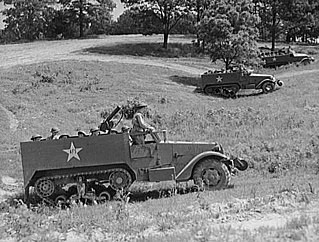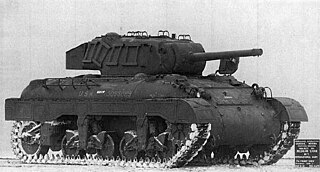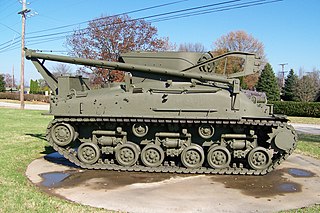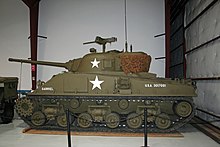
The M4 Sherman, officially Medium Tank, M4, was the most widely used medium tank by the United States and Western Allies in World War II. The M4 Sherman proved to be reliable, relatively cheap to produce, and available in great numbers. It was also the basis of several other armored fighting vehicles including self-propelled artillery, tank destroyers, and armored recovery vehicles. Tens of thousands were distributed through the Lend-Lease program to the British Commonwealth and Soviet Union. The tank was named by the British after the American Civil War General William Tecumseh Sherman.

The M3 Lee, officially Medium Tank, M3, was an American medium tank used during World War II. The turret was produced in two forms, one for US needs and one modified to British requirements to place the radio next to the commander. In British Commonwealth service, the tank was called by two names: tanks employing US-pattern turrets were called "Lee", named after Confederate general Robert E. Lee, while those with British-pattern turrets were known as "Grant", named after Union general Ulysses S. Grant.

The AMX-13 is a French light tank produced from 1952 to 1987. It served with the French Army, as the Char 13t-75 Modèle 51, and was exported to more than 26 other nations. Named after its initial weight of 13 tonnes, and featuring a tough and reliable chassis, it was fitted with an oscillating turret built by GIAT Industries with revolver-type magazines, which were also used on the Austrian SK-105 Kürassier. Including prototypes and export versions, over a hundred variants exist, including self-propelled guns, anti-aircraft systems, APCs, and ATGM versions.

The M113 is a fully tracked armored personnel carrier (APC) that was developed and produced by the FMC Corporation. The M113 was sent to United States Army Europe in 1961 to replace the mechanized infantry's M59 APCs. The M113 was first used in combat in April 1962 after the United States provided the South Vietnamese army (ARVN) with heavy weaponry such as the M113, under the Military Assistance Command, Vietnam (MACV) program. Eventually, the M113 was the most widely used armored vehicle of the U.S. Army in the Vietnam War and was used to break through heavy thickets in the midst of the jungle to attack and overrun enemy positions. It was largely known as an "APC" or an "ACAV" by the allied forces.

The M3 half-track was an American armored personnel carrier half-track widely used by the Allies during World War II and in the Cold War. Derived from the M2 half-track car, the M3 was extensively produced, with about 15,000 standard M3s and more than 38,000 variant units manufactured.

An armoured recovery vehicle (ARV) is typically a powerful tank or armoured personnel carrier (APC) chassis modified for use during combat for military vehicle recovery (towing) or repair of battle-damaged, stuck, and/or inoperable armoured fighting vehicles, such as tanks and armoured personnel carriers. Most ARVs have motorized tracks, like a tank or bulldozer, enabling the ARV to operate on uneven ground. The term "Armoured Repair and Recovery Vehicle" (ARRV) is also used.

The Independent Nasserite Movement – INM (Arabic: حركة الناصريين المستقلين-المرابطون, romanized: Harakat al-Nasiriyin al-Mustaqillin) or simply Al-Murabitoun (المرابطون lit. The Steadfast), also termed variously Independent Nasserite Organization (INO) or Movement of Independent Nasserists (MIN), is a Nasserist political party in Lebanon.

The M4 Sherman tank was produced in several variants, a result of mass production spread across several manufacturers and several years. It was also the basis for a number of related vehicles and Shermans have been modified by several nations, ranging from upgrades to complete hull conversions for another task. Originally designed in 1941, M4 variants were still used by Israel during the 1967 and 1973 wars with its Arab neighbors.

This article deals with Sherman tanks extensive use around the world after World War II and catalogues foreign post–World War II use and conversions of Sherman tanks and variants based on the Sherman chassis.

The Medium Tank T20, Medium Tank T22 and Medium Tank T23 were prototype medium tanks, developed by the United States Army during World War II. They were designed as successors to the M4 Sherman. The standard main weapon for production versions of these designs was to be the 76 mm M1.

The 76 mm gun M1 was an American World War II–era tank gun developed by the U.S United States Ordnance Department in 1942 to supplement the 75 mm gun on the basic Medium tank M4. It was also used to arm the M18 Hellcat tank destroyer.

Yad La-Shiryon is Israel's official memorial site for fallen soldiers from the armored corps, as well as one of the most diverse tank museums in the world. The cornerstone for Yad La-Shiryon was laid on December 14, 1982.

The AMX-VCI is one of the many variants of the French AMX-13 light tank. It was the front line APC of the French Army until replaced by the AMX-10P. It is still used by some countries, for example Mexico, where it goes under the name of DNC-1 and is armed with a 20mm cannon.

The Lebanese Forces was one of the main Lebanese Christian factions of the Lebanese Civil War. Originally an umbrella organization for different parties, the Lebanese Forces later became a separate organization. The Lebanese Forces replaced the previous Kataeb Regulatory Forces as the military arm of the Christian Kataeb Party. It was mainly staffed by Maronite Christians loyal to Bachir Gemayel, and fought against the Lebanese National Movement, the Palestine Liberation Organization and the Syrian Army among other enemies. The group gained infamy for their perpetration of the 1982 Sabra and Shatila massacre, which primarily targeted Palestinian refugees following Gemayel's assassination.

The AIL M325 Command Car is a 4x4 military truck produced by the Automotive Industries Limited (AIL) of Nazareth in Israel from 1970 to 1993 for use by the Israel Defense Forces. The M325 is a light, versatile truck designed for carrying up to 12 troops and radio equipment while being fitted with up to four 7.62 mm machine guns. Mechanically, it is based on the Dodge Power Wagon, which it succeeded in service for the Israel Defense Forces.

This article deals with the history and development of tanks of the Israeli Army, from their first use after World War II in the establishment of the State of Israel after the end of the British Mandate, and into the Cold War and what today is considered the modern era.

The Medium Tank M7, initially Light Tank T7, was an American tank, originally conceived as an up-gunned replacement for the Light Tank M3/M5 ("Stuart"). The project developed to mount the same 75mm armament as the M4 Sherman while retaining the light weight and maneuverability of the M3 Stuart; however, during development the weight of the prototype surpassed the US Army's standard for light tanks and crossed into the medium tank category and was renamed. The M7 had significantly less armor than the M4 Sherman, no greater firepower, and held only a slight advantage in top speed. For these reasons, and because the M4 was already battle-tested and in full production, the M7 was cancelled in 1943.

The M32 Armored Recovery Vehicle was an armored recovery vehicle (ARV) used during World War II and the Korean War by the United States, and was based on the chassis of the M4 Sherman medium tank. During World War II, the British also used several hundred M32s, which were obtained through Lend-Lease in 1944. The first four prototypes were produced in January 1943, labeled T5, T5E1, T5E2, T5E3, and T5E4. After a series of tests at the Aberdeen Proving Grounds, the prototypes were approved as M32, M32E1, M32E2, M32E3, and M32E4. However, the M32E4 never entered production. There were also variants that had Horizontal Volute Spring Suspension (HVSS), which were demarcated by the suffix "A1" after the model number.





















